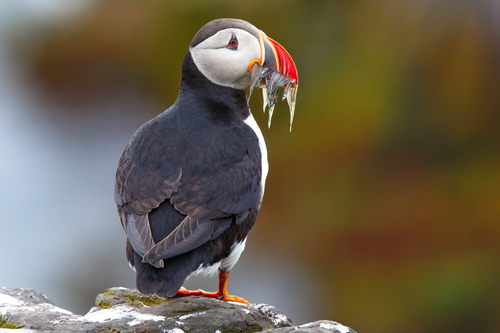
Atlantic Puffin
The Atlantic Puffin (*Fratercula arctica*) is a charismatic seabird known for its brightly colored beak during the breeding season. It plays a vital role in the marine ecosystem as both predator and prey. Often called the "clown of the sea" or "sea parrot," this bird has captured public imagination and is a symbol of many North Atlantic coastal regions. It is an important indicator species; changes in puffin populations can signal broader environmental issues, such as fluctuations in fish stocks or the impacts of climate change.
28-30 cm
Length
47-63 cm
Wingspan
Vulnerable
Conservation Status
Distribution
The Atlantic Puffin breeds on coasts and islands in the North Atlantic Ocean, including Iceland, Norway, Greenland, Newfoundland, and the Faroe Islands. It winters in the open ocean, ranging as far south as the Mediterranean Sea and North Carolina.
Lifespan
Typically around 20 years in the wild, but can exceed 30 years.
Atlantic Puffin's Habitat
Habitat Types
Coastal cliffs, Rocky islands, Open ocean (during winter)
Climate Zones
Boreal, Temperate
Adaptations
Atlantic Puffins have dense, waterproof plumage for insulation in cold waters. Their strong wings are adapted for both flying and swimming underwater. They possess salt glands above their eyes to excrete excess salt, a crucial adaptation for a marine bird.
Variations
There are three recognized subspecies: *F. a. arctica*, *F. a. grabae*, and *F. a. naumanni*. These subspecies differ slightly in size and bill dimensions, primarily based on their geographic breeding locations.
Appearance
Breeding Plumage
Breeding plumage includes a brightly colored beak, orange legs, and prominent eye ornaments. Non-breeding plumage is duller, with a smaller, less colorful beak and greyish cheeks.
Seasonal Feather Changes
The colorful beak plates are shed after the breeding season, leaving a smaller, duller bill for the winter.
Sex Based Plumage Differences
Males and females have similar plumage, although males tend to be slightly larger.
Notable Features
Brightly colored, laterally compressed beak (breeding season), Black 'necklace' around the throat, White underparts and black upperparts
Diet and Feeding
Primary Foods
Small fish (e.g., sand eels, herring, capelin), Crustaceans, Squid
Foraging Behavior
Atlantic Puffins dive underwater, using their wings to 'fly' through the water and their feet for steering. They can hold multiple small fish in their beaks at once, thanks to backward-pointing spines on their tongues and upper palates.
Specializations
The specialized beak and tongue allow for efficient capture and carrying of multiple prey items during a single dive.
Seasonal Diet Variations
Diet can vary depending on the availability of prey species, with some regional and seasonal differences in the proportions of fish, crustaceans, and squid consumed.
Behavior
Social Structure
Highly colonial during the breeding season, forming large colonies on cliffs and islands. Outside of breeding, they are largely solitary or in small groups at sea.
Communication
Growls and grunts within the burrow, Billing (clacking beaks together) during courtship, Visual displays, such as puffing up their bodies
Migration
Atlantic Puffins undertake extensive migrations, spending the winter months at sea. They disperse widely across the North Atlantic.
Territorial or Group Behaviors
They defend a small area around their burrow entrance. Within the colony, they exhibit various social interactions, including displays and vocalizations.
Conservation
Threats
Overfishing of prey species, Climate change (affecting prey distribution and breeding success), Pollution (oil spills, plastic ingestion), Predation by introduced species (e.g., rats, cats on breeding islands), Human disturbance
Protection Programs
Marine Protected Areas, Seabird monitoring programs, Efforts to reduce bycatch in fisheries, Habitat restoration projects
Local National Laws
Protected under various national and international laws, including the Migratory Bird Treaty Act in the US and Canada, and the Birds Directive in the EU.
Population Trend
Decreasing
Population Estimates
Estimated global population is around 12-14 million mature individuals, but significant declines have been observed in some regions.
Interesting Facts
Puffins can dive to depths of up to 60 meters (200 feet).
This allows them to reach prey that other seabirds cannot access.
They can carry multiple fish in their beak at once.
This is facilitated by serrations on their beaks and a specialized tongue.
Puffins are sometimes called 'sea parrots' due to their colorful beaks.
The bright colors are only present during the breeding season.
Puffin chicks are called 'pufflings'.
A single puffling is raised in a burrow each year.
Puffins use their sharp claws and beaks to dig their burrows.
These burrows can be up to 2 meters (6.5 feet) long.
Faqs about Atlantic Puffin
Where can I see Atlantic Puffins?
Atlantic Puffins can be seen on coastal cliffs and islands in the North Atlantic during the breeding season. Popular viewing locations include Iceland, Norway, Newfoundland, and the UK (e.g., Skomer Island, Shetland Islands).
What do puffins eat?
They primarily eat small fish, such as sand eels, herring, and capelin. They also consume crustaceans and squid.
How long do puffins live?
They typically live for around 20 years, but some individuals can live longer than 30 years.
Are Atlantic Puffins endangered?
They are currently listed as Vulnerable by the IUCN, meaning they face a high risk of endangerment in the wild.
Do puffins mate for life?
Puffins often form long-term pair bonds and return to the same burrow each year, but 'divorce' can occur.
Copyright @ Nature Style Limited. All Rights Reserved.
 English
English